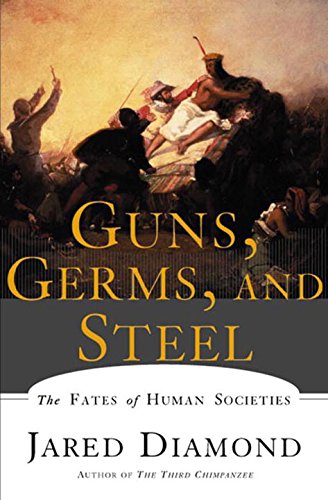
I finally finished a book! We all (including myself) thought I’d get a bunch read during Covid. No luck. I was really guilty of starting a few, then getting bogged down, forgetting to continue and then losing all the momentum I had and having to shelve it because I forgot where I was and what the hell had happened. I do plan to get back to those books but they remain on hold as I finished this, something I’ve been dying to complete despite it being about 25 years old and the last epilog it had was dated around 2003. Oh, I’m now reading something entertaining to cleanse my palette before I jump into another educational opus.
If you haven’t read GG&S, I highly recommend it as it gave me some new perspective on how Civilizations and History have played out. Many will giggle at how another takeaway I got, how it will influence elements of my D&D worlds too, more as we go.
Diamond’s book proposes a hypothesis (his evidence isn’t ironclad enough for a theory) on why Western Civilization and China, until the Enlightenment, came out on top in the time we live in, aka the 21st Century. The short version, Eurasia had the good luck to be the home of the widest variety of plants and animals on Earth. Since not all plants (e.g. acorns) nor animals (e.g. elephants and alpacas) are suitable for domestication, the advantage goes to wherever the most diversity resides. In Eurasia’s case, there were dozens of both for humans to work with until we succeeded with the horse, cow, sheep, pig, chicken, goat, wheat, rice, barley, apples, so on. Then throw in how easily the technology and know-how could migrate east-to-west/west-to-east alongside all these areas having similar climates, making implementation practical.
Once agriculture is instituted, all Historians, Archaeologists and Anthropologists agree, a civilization will take root. All the trappings eventually follow: government, writing, new technology, organized religion, time keeping, etc. Depending upon the resources, nearby competition and what energy they’re utilizing (human, animal, hydro or carbon), you should see mining, industrialization, powerful weapons and larger political operations. Put this altogether and it provides a reasonable explanation why the Europeans crossed the Atlantic, Pacific and Indian Oceans to dominate five other continents until recently.
What about China? They were in the running too as per Diamond’s writings. Now I’ve read the argument he chooses from other writers here; pre-Communist China was a larger, more homogeneous empire at peace around the same time. Peace allegedly breeds complacency, complacency leads to less innovation. There was a brief time China did send ships to India and Africa around the era of Columbus. The Chinese always had the means as long-range sailing wasn’t exclusive to the Europeans. What changed? A political decision happened ordering the expeditions to stop and the fleets were destroyed. The early modern European states were much smaller and constantly at war with each other. Grabbing more turf, inventing more brutal weapons and traveling faster were the side effects. However, Diamond agrees with me on one major point, there’s a hard-to-find sweet spot between too much order/peace and being too decentralized/in conflict to get “progress.” Libertarians and small government idiots don’t have a good argument.
With the previous explanation I surmised in the third and fourth paragraphs, it’s obvious that the shaming finger of racism has been leveled at the book. I utterly disagree with those lazy critics; I seriously doubt few read GG&S. Firstly, the other continents had geographical barriers preventing the spread of what Eurasians had. Secondly, they had fewer species to get success with: corn and potatoes are great but you won’t get far without horses or oxen. Lastly, all the Eurasian crops, animals and advancements have been distributed around the globe, there’s nothing stopping other civilizations climbing to the top as time moves on. Besides, Diamond never made a judgment call saying the First Nations, Black Africans or the First Australians were or are too stupid to use the tech Eurasians developed. Quite the opposite, early on he points out how the Maori used the guns and food they acquired from Europeans to wipe out or enslave rivals.
I want to close out with how I will utilize some of the book’s lessons in my D&D game. It will pertain to languages. The majority only developed a written element when they’re spoken by sedentary peoples, often with agriculture which leads to bureaucracy. So certain monsters will only have a verbal language sans writing due to their nomadic and maybe predatory natures. Monsters who also raid other settlements for food and resources will get a little boost too, namely better motivations on why they do those things.
